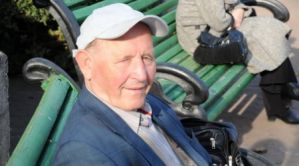Mathematician. Leader of the “Democratic Union of Socialists” (1964).
He was born in a Moldovan village. He was officially registered as Russian. His father worked on the railroad and was able to provide for five children. He hated communism, a sentiment passed down to his children. In 1945, based on a denunciation, he was accused of reading English newspapers, although he did not know English. The family endured great hardship during the famine of 1946. From a young age, Mykola read the works of Lenin and Marx and was already critical of their teachings.
In 1957, he wrote and sent a paper to N. Khrushchev titled “An Analysis of the State of Agriculture,” proposing reforms or else the country would soon have to buy food abroad, which eventually happened. He received a reply that the party was preparing a reform.
He graduated from the Faculty of Physics and Mathematics at Odesa University. He worked as the director of a school for working youth. He concluded that it was necessary to create a political party alternative to the CPSU—the “Democratic Union of Socialists.” He gathered up to 12 people, and soon the underground organization, structured in “trios,” grew to 30 members.
In February 1964, the DSS set up an underground printing press in the village of Serpneve (the font was stolen by Mykola Tarnavsky, who worked in a printing house), and they printed 1,500 copies of an “Appeal” (in the form of a newspaper) on behalf of the “Democratic Union of Socialists” with criticism of CPSU policy and calls to create a democratic society. The newspaper was sent from various cities to other cities: Odesa, Chișinău, Sverdlovsk, Kyiv, Gorky, Chelyabinsk, Petropavlovsk, and Leningrad.
The organization was exposed through a student, Mykola Kucheryanu, who gave his father in the village several copies of the “Appeal,” and the father then mailed them to local authorities, signing the envelopes with his own name. Within a few days, the organization was arrested; Drahosh on May 16, 1964.
To add weight to the case, Drahosh portrayed the DSS as part of a large, all-Union organization. Many uninvolved people, primarily intellectuals from Odesa and Chișinău, were summoned for interrogation. According to Drahosh, the arrested were not beaten, and some investigators (Borys Ostapchuk) were even sympathetic to them. However, Drahosh was not served with the indictment, and he was given only 2 hours to review the 7-volume case file, with no permission to take any notes. Since the lawyer did not support Drahosh’s defense strategy, he dismissed him. He expected the death penalty and was surprised by the sentence of 7 years in a strict-regime camp.
He was convicted by the Supreme Court of the Moldavian SSR on September 19, 1964, under Articles 67 Part 1 of the MSSR Criminal Code, 69 of the MSSR Criminal Code, and 81 Part 2 of the UkrSSR Criminal Code. Along with Drahosh, carpenter M. Tarnavsky, teacher I. Cherdyntsev, and students V. Pastalaki, S. Chemyrtan, and M. Kucheryanu were also sentenced. The trial was closed.
Drahosh served his sentence in the Dubravlag camps (Mordovia). In early 1970, he organized a protest hunger strike in which, among others, V. KULYNYN, Stepan Zatikyan, and Mykola Tarnavsky participated. For this, they were transferred by a court on July 13 to a prison regime for the remainder of their term and sent to the Vladimir Central Prison. There, he was imprisoned with, among others, A. GINSBURG.
After his release, he returned to his home village. In 1974, he organized an escape abroad for a former political prisoner. That same year, he himself had to flee abroad.
In Paris, he organized the “Party of Political Emigrés from the USSR,” which led to an attempt to poison him. In 1988, he published a book on the need for democratization in the USSR, in which he put forward a program for the transition from a planned to a market economy and the idea of a “Union of Sovereign Republics,” which the new Soviet leadership soon tried to implement.
In 1991, Drahosh spoke at the USSR Academy of Sciences and at the General Staff of the Soviet Army.
He currently lives in Frankfurt am Main, Germany, is married to a Spanish woman, and they have two adult children.
In 2010, when acting President of Moldova Mihai Ghimpu opened the archives with materials on the persecution of dissidents, Drahosh came to Chișinău, participated in the public disclosure ceremony, and reviewed his own case file. He gave a number of interviews.
Bibliography:
KhTS, issue 15 (1970).
58-10. Supervisory Proceedings of the USSR Prosecutor's Office in Cases of Anti-Soviet Agitation and Propaganda. March 1953 – 1991. Annotated Catalog. Edited by V. A. Kozlov and S. V. Mironenko; compiled by O. V. Edelman, Moscow: International Foundation “Democracy,” 1999. – 944 p. (Russia. XX Century. Documents). – p. 662.
Interview by H. Hayovyi on June 16, 1999: https://museum.khpg.org/1120845382
Interview with V. Kulynin on February 20, 2001: https://museum.khpg.org/1273090857
Stanislav Luzhansky. How a Moldovan Dissident Scared Khrushchev. – Pan.md.
“The Investigation Has Established…”. – http://www.point.md. – November 9, 2010.
International Biographical Dictionary of Dissidents in Central and Eastern Europe and the Former Soviet Union. Vol. 1. Ukraine. Part 1. – Kharkiv: Kharkiv Human Rights Protection Group; “Prava Lyudyny.” – 2006. – pp. 1–516; Part 2. – pp. 517–1020; Part 3. – 2011. – Drahosh: M., pp. 1118-1120: Archive of the Kharkiv Human Rights Protection Group: https://museum.khpg.org/1291900918
The Resistance Movement in Ukraine: 1960–1990. An Encyclopedic Guide / Foreword by Osyp Zinkevych, Oles Obertas. – Kyiv: Smoloskyp, 2nd ed., 2012. – 896 p. + 64 ill.; Drahosh: p. 241.
Vasyl Ovsiyenko, Kharkiv Human Rights Protection Group, December 9, 2010. Last read on May 16, 2016.
DragoshM Characters 5,025

DRAGOSH MYKOLA FEDOROVYCH